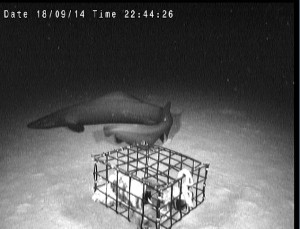
This fall, CEI’s Deepwater Project is continuing use of The Medusa, a specialized deepwater camera that can provide footage from up to 2000 meters underneath the ocean’s surface. The unit is on loan from Dr. Edie Widder of Ocean Research Conservation Association (ORCA). Footage collected from the camera will shed light on the diversity, distribution, and species assemblages of deep-water fauna present within the Exuma Sound trench community. A working understanding of healthy deep-water communities has become increasingly important in recent years as shallow-water overfishing pushes to expand the deep-sea fishing industry.
In this third year of surveys with The Medusa in the Exuma Sound, the camera is heading to greater depths than before. She reached 916 meters for her first deep-sea drop and was just recovered from 1205 meters. These increasing drop depths will yield a more complete picture of community variation over depth gradients. In a fall semester course with students from The Island School, new videos will be analyzed for species abundance and diversity.

Past drops of The Medusa have filmed Bathynomus giganteus, Squalus cubensis (Cuban Dogfish), different species of Centrophorus (Gulper sharks), Synaphobranchidae (Cutthroat eel), and Hexanchus (Sixgill shark). This fall, for the first time ever, a Pseudotriakis microdon, or False Catshark, was seen circling the bait. Stay tuned for more updates on the observed deep-sea communities in the Exuma Sound!